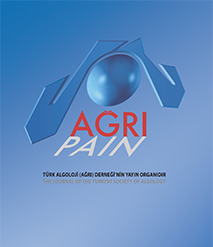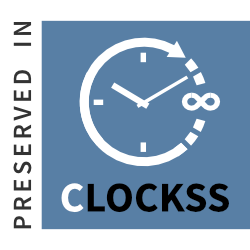Quick Search
Volume: 27 Issue: 4 - 2015
| 1. | Front Matter Pages I - VI |
| EXPERIMENTAL AND CLINICAL STUDIES | |
| 2. | Effects of Combined Epidural Analgesia with Total Intravenous Anesthesia on Risky Patients Underwent Major Abdominal Surgery Tülin Akarsu Ayazoğlu, Aynur Özensoy, Fatih Doğu Geyik, Muhittin Çalım, Uğur Duman, Mehmet Akif Candan PMID: 26860490 doi: 10.5505/agri.2015.09609 Pages 171 - 180 Background and Objectives: The aim of this study is to investigate the effects of combined epidural analgesia with total intravenous anaesthesia and only total intravenous anaesthesia on the different clinical parameters. Methods: Sixty high risk patients undergoing a major abdominal surgical procedure were included in this prospective, double blind, randomized study. Induction of anaesthesia was performed with IV remifentanil 0.5µg/kg and propofol titrated to achieve bispectral index score between 40 and 50. After intubation; in Group E, 0.1% bupivacaine and 2 µg/mL fentanyl were administered by an infusion rate at 0. 15 ml/kg/h via the epidural catheter and Group C received epidural normal saline as same infusion rate. Results: In group E, intraoperative MAP values were significantly lower than those in group C (p<0.05). Time of extubation, time of eye opening with audible warning and time of verbal response was significantly lower in group E than those in group C. Total anaesthetic drug consumption was significantly higher in group C than those in group E (p <0.05). Conclusions: Based on lower requirements for propofol and remifentanil as well as the favourable effects on clinical parameters; we conclude that bispectral index score guided combined epidural with total intravenous anaesthesia is superior to solely total intravenous anaesthesia in this type of surgery. |
| 3. | The Effects of Fatigue and Pain on Daily Life Activities in Systemic Lupus Erythematosus Filiz Özel, Gülümser Argon PMID: 26860491 doi: 10.5505/agri.2015.38278 Pages 181 - 189 Objective: The aim of this study was to determine the effects of pain and fatigue on daily life activities of Systemic Lupus Erythematosus patients. Methods: The study sample included 74 Systemic Lupus Erythematosus patients who presented to outpatient departments of a university hospital and two local hospitals between 30.9.2009 and 15.5.2010. Data was collected using the Fatigue Severity Scale, Katz’s Activity's Daily Living Index, Lawton and Brody’s Instrumental Activities of Daily Living, and the McGill Pain Questionnaire. Results: The mean scores were 6.0 (fatigue) on the Fatigue Severity Scale, 18.0 (independent) on the Daily Life Activities Index, 24.0 (independent) on the Instrumental Daily Life Activities Index, and 1.56 (discomforting) on the McGill Pain Scale for pain felt at the moment of questioning. A low-level negative relationship was observed between the scores on the Fatigue Severity Scale and the Daily Life Activities Index (p<0.05, r = -0.298), and between Fatigue and Instrumental Daily Life Activities scores (p<0.05, r = -0.354). A medium-level positive relationship was observed between the scores on the Fatigue Severity Scale and the McGill Pain Scale (p<0.05, r = 0.478). Conclusion: This study determined that pain and fatigue affected the daily lives of Systemic Lupus Erythematosus patients. The study should be repeated on a larger sample. |
| 4. | Efficacy of conventional ultrasound therapy on myofascial pain syndrome: A placebo controllled study Gülis Kavadar, Nil Çağlar, Şeyma Özen, Şule Tütün, Demet Demircioğlu PMID: 26860492 doi: 10.5505/agri.2015.48569 Pages 190 - 196 Objectives: Myofascial pain syndrome (MPS) is a complex pain syndrome characterized with trigger points (TP) in skeletal muscles. We aimed to assess the efficacy of ultrasound (US) therapy, which is one of the main devices used in physical rehabilitation, for the treatment of TP in MPS. Materials and Methods: 59 patients (49 females, 10 males) with active TP on the upper trapezius fibers were randomized into the treatment (n=30) and the control groups (n= 29). The treatment group received conventional US therapy for 6 minutes, on 1,5 Watt/cm2 dose with 1 MHz frequency for 15 days whereas a placebo US therapy was administered to the control group. Prior to the treatment, immediately and 3 months later pain severity during rest and physical activity was assessed with visual analog scale (VAS), TP tenderness was measured with 0-5 scale, pressure pain threshold (PPT) was analyzed with algometer and the depression level was evaluated with Beck’s depression questionnaire (BDP) by a clinician blinded to the groups. Results: The mean age of the patients were 37.43±9.07 and 35.83± 5.68 years, in the treatment and control groups, respectively. Compared to the pre-treatment values VAS, 0-5 scale and BDP scores decreased (p < 0.01) along with an increase in PPT (p < 0.01) in both groups at the follow-up visits. 0-5 scales and BDP scores were significantly lower and PPT was significantly higher in the treatment group, compared to the control group (p<0.001).Our results revealed that US treatment is effective on MPS. |
| 5. | Pain Evaluation In Patients With Chronical Renal Failure Undergoing Hemodialysis Sümeyra Yeşil, Bilge Karslı, Nurten Kayacan, Gültekin Süleymanlar, Fevzi Ersoy PMID: 26860493 doi: 10.5505/agri.2015.44712 Pages 197 - 204 Objective: Hemodialysis is a vital therapy in treatment of chronical renal failure. Pain is a complaint seen at every stage of chronical renal failure and is a part of clinical status. We aimed to investigate pain and its causes and the sufficiency of pain treatment in use. Methods: Patients aged 18 – 60 undergoing hemodialysis were included in this study. Pain evolution was obtained by form of Algology. Neuropathic pain symptoms and signs were evaluated by using LANNS. Results: 53 patients undergoing hemodialysis (75.7%) complained of pain. The types of pain were recorded to be headache (31 patients, 58.5%), lower extremity pain (21 patients, 39.6%) and pain due to cramps (28 patients, 52.8%). We saw that 81.4% of our patients were capable of doing on their own and that the pain did not affect daily activities of our patients. There were 37 patients (71.8%) who had LANSS score ≥ 12. Patients included in this study answered the question “Did you get any treatment for this pain?” as NO in 58.5% (31 patients) and as YES in 41% (21 patients). Nevertheless, 29 patients (54.7%) stated that they used drugs because of the pain and 24 patients (45.3%) stated that they haven’t used any drugs for pain management. Conclusion: The patients with chronical diseases like chronical renal failure, we believe that pain should be interrogated and assessed and along with the treatment of chronical renal failure, patients should be treated for pain and a pain-free life must be provided to these group of patients. |
| 6. | The donor site pain assessment of the Patients who were reconstructed Split-Thickness Graft Emine Yüksel Delice, Bahire Ulus PMID: 26860494 doi: 10.5505/agri.2015.04695 Pages 205 - 209 Objective: İn this study we examined the donor site pain intensity of the patients who were reconstructed by split thickness skin graft (STSG) due to tissue defect. Methods: This descriptive study was performed in a Plastic and Reconstructive Surgery Clinic of a State Hospital in Istanbul. Sampling selection wasn’t made, all (31) cases were studied with STSG in 2013. As data collection forms, we used Patient Information Form and Visual Analog Scale (VAS). In the analysis of the data percentage, Kruskal-Wallis and Mann-Whitney-U tests were used. Results: 38.71% of the patients were female and 61.29% were male. It was determined that grafting application was mostly made in the lower extremity and 61% of the patients were able to perform individual functions independently. It was observed that pain intensity increased as the donor area expanded. It was also determined that semi-dependent patients’ pain intensity was higher than independent patients’. In 64.52% of the patients graft donor area was wider than 10cm². The postoperative pain intensity of the patients who were reconstructed by STSG in the lower extremity was higher than patients who were reconstructed by STSG in the upper extremity area. Conclusion: It was observed that the donor area pain intensity of patients was the most severe on the first day after surgery and the least severe on the sixth day after surgery. In conclusion, the pain evaluation of the donor area has to be assessed by the nurse on the first day after surgery. |
| CASE REPORTS | |
| 7. | Analgesic Efficacy Of Transversus Abdominis Plane Block In Neonates And Early Infants For Colostomy And Reversal Of Colostomy Chee Kean Chen, Shu Ching Teo, Vui Eng Phui, Mat Ariffin Saman PMID: 26860495 doi: 10.5505/agri.2015.66487 Pages 210 - 214 The application of ultrasound-guided transversus abdominis plane (TAP) block in paediatric population is gaining popularity among anaesthetists. We present a case series of ultrasound-guided TAP block in ten neonate and infants undergoing colostomy and reversal of stoma. Classical TAP as described by Hebbard was carried out and a maximum dosage of 1ml/kg of 0.25% levobupivacaine was injected. Pain score was assessed using Neonatal Infant Pain Scale for 24 hours. In all patients, the block was successful with minimal hemodynamic changes intraoperatively and no additional systemic analgesia was needed intraoperative and immediate postoperatively. Ultrasound-guided TAP block has an important role in providing safe and effective analgesia for colostomy creation and reversal of stoma surgeries in paediatric population. |
| 8. | The Application Of Epidural anesthesıa in Pregnant Woman With Uncorrected Tetralogy Of Fallot: A Case report Filiz Alkaya Solmaz, Handan Cuhruk PMID: 26860496 doi: 10.5505/agri.2015.81994 Pages 215 - 218 Tetralogy of Fallot is the most common cyanotic congenital cardiac disease. The hemodynamic changes which are present immediately after abdominal delivery may be resulted with serious, life-threatening multiorgan complications. Therefore the choice of anesthesia is very difficult. We describe the case of pregnant, 33 weeks gestation, with uncorrected tetralogy of Fallot who underwent caesarian section. The epidural anesthesia was performed uneventfully. After having stabile vital signs and a good general condition patient was followed up at the intensive care unit for 4 days. She was transferred to the obstetric service. We think that application of epidural anaesthesia with fragmented and increasing doses of slow levobupivacain in pregnant women with tetralogy of Fallot is safe. Nonetheless, this data of ours will grow stronger with the increase of the clinical application amount. Keys words: Caesarean section, tetrology of Fallot, epidural anaesthesia |
| 9. | Painful Ophthalmoplegia: A Case Report And Literature Review Ferda İlgen Uslu, Mustafa Özkan PMID: 26860497 doi: 10.5505/agri.2015.67699 Pages 219 - 223 Introduction: Painful ophthalmoplegia consists of periorbital or hemicranial pain with ipsilateral ocular motor nerve palsies. There are many etiologies of painful ophthalmoplegia. Tolosa-Hunt syndrome (THS) is an uncommon disease caused by non-specific inflammation of the cavernous sinus, superior orbital fissure and the apex of the orbit. Case presentation: A 45-year-old female reported episodes of reversible left eye pain and diplopia. Examination showed periorbital oedema and left palpebral semiptosis, paresis of the partial left third nerve palsy with normal pupillary reactions, fourth and sixth left cranial nerves, and hypoesthesia over the first and second division of the left trigeminal nerve. Blood analysis, postcontrast cranial and orbital magnetic resonance (MR) imaging, cranial MR angiography and CSF analysis demonstrated no abnormalities. The clinical diagnosis satisfies the criteria for " Tolosa-Hunt syndrome ". After steroid therapy her symptoms and clinical signs dramatically reverses. Conclusion: Painful ophthalmoplegia with inflammatory conditions such as Tolosa Hunt syndrome is highly responsive to corticosteroids but should be diagnoses of exclusion. The THS diagnosis should be used rarely and with great caution. |
| LETTER TO THE EDITOR | |
| 10. | An Overlooked Clinical Entity: Notalgia Paresthetica Ömer Faruk Elmas, Okan Kızılyel, Mahmut Sami Metin, Mustafa Atasoy, Selin Merih Urlu, Kutsi Tuncer PMID: 26860498 doi: 10.5505/agri.2015.23540 Pages 224 - 225 An Overlooked Clinical Entity: Notalgia Paresthetica |





